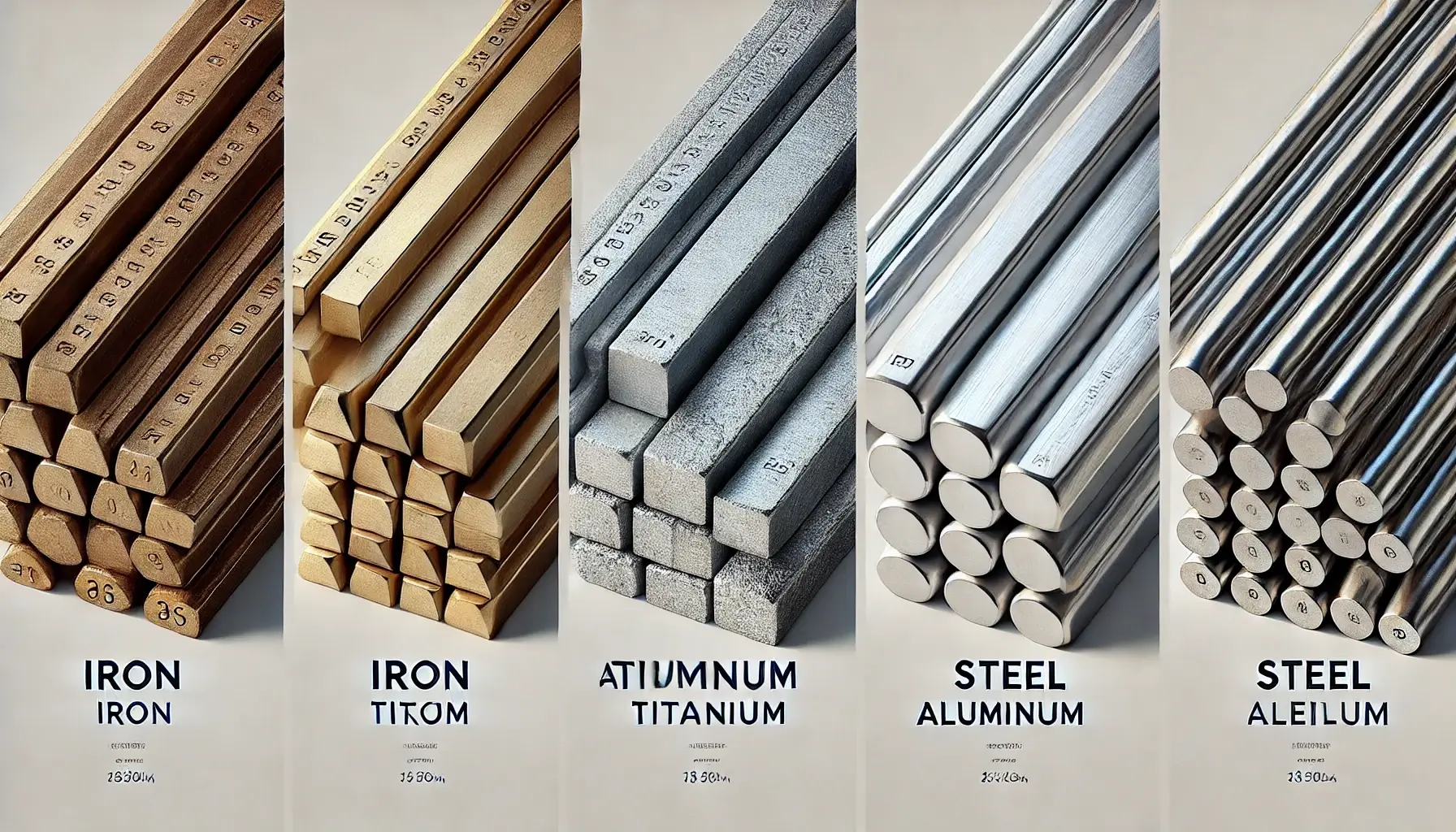Iron vs Titanium vs Aluminum vs Steel
Understanding the differences between iron, titanium, aluminum, and steel is essential for selecting the right material for various applications. Each of these metals has unique properties that make them suitable for specific uses.
Table Compare Iron vs. Titanium vs. Aluminum vs. Steel
| Property | Iron | Titanium | Aluminum | Steel |
|---|---|---|---|---|
| Composition | Pure element | Pure element or alloyed | Pure element or alloyed | Alloy of iron and carbon, with other elements |
| Density | High (7.87 g/cm³) | Medium (4.5 g/cm³) | Low (2.7 g/cm³) | Varies; typically 7.75 – 8.05 g/cm³ |
| Strength | High, especially in cast form | Very high strength-to-weight ratio | Moderate, less than iron and steel | High, varies with type (carbon, alloy, stainless) |
| Corrosion Resistance | Low, prone to rust | Excellent, highly resistant | Good, forms protective oxide layer | Varies; stainless steel has excellent resistance |
| Thermal Conductivity | Moderate (80 W/m·K) | Low (21.9 W/m·K) | High (237 W/m·K) | Varies; lower in stainless steel |
| Electrical Conductivity | Moderate (10.1 MS/m) | Low (2.38 MS/m) | High (37.7 MS/m) | Moderate (6.99 MS/m) |
| Cost | Low | High | Moderate | Varies; generally moderate |
| Weight | Heavy | Light | Very light | Varies; typically heavier than aluminum, lighter than iron |
| Applications | Construction, machinery, automotive parts | Aerospace, medical implants, sports equipment | Aircraft, automotive, packaging | Construction, automotive, appliances, tools |
What is Iron?
Iron is a pure element commonly used in construction and manufacturing. It is known for its strength and durability, particularly in cast form, but it is prone to rust when exposed to moisture and air.
Common Applications of Iron:
- Construction: Used in structural components such as beams and girders.
- Machinery: Essential in manufacturing heavy machinery and industrial equipment.
- Automotive: Used in engine blocks and other heavy-duty parts.
What is Titanium?
Titanium is a pure element known for its high strength-to-weight ratio and excellent corrosion resistance. It is commonly used in high-performance applications requiring lightweight and durable materials.
Common Applications of Titanium:
- Aerospace: Used in aircraft components and spacecraft.
- Medical Implants: Ideal for joint replacements and dental implants due to its biocompatibility.
- Sports Equipment: Used in high-performance bicycles and golf clubs.
What is Aluminum?
Aluminum is a pure element or alloy known for its low density, good corrosion resistance, and high thermal and electrical conductivity. It is widely used in applications requiring lightweight materials.
Common Applications of Aluminum:
- Aircraft: Used in the construction of aircraft bodies and components.
- Automotive: Used in car bodies and engine components to reduce weight and improve fuel efficiency.
- Packaging: Widely used in beverage cans and food packaging due to its non-toxicity and corrosion resistance.
What is Steel?
Steel is an alloy of iron and carbon, often with other elements to enhance its properties. It is known for its high strength and versatility, making it one of the most commonly used materials in the world.
Common Applications of Steel:
- Construction: Used in building frameworks, bridges, and reinforcing bars.
- Automotive: Essential in manufacturing car bodies, engines, and other components.
- Appliances: Used in making durable home appliances such as refrigerators and washing machines.
Key Differences and Applications
Density and Weight:
- Iron: Heaviest among the four, suitable for applications requiring high strength.
- Titanium: Lightweight and strong, ideal for aerospace and medical applications.
- Aluminum: Very lightweight, commonly used where weight reduction is crucial.
- Steel: Moderate weight, versatile for various applications from construction to automotive.
Corrosion Resistance:
- Iron: Prone to rust, often needs protective coatings.
- Titanium: Highly resistant to corrosion, suitable for harsh environments.
- Aluminum: Good resistance, forms a protective oxide layer.
- Steel: Varies; stainless steel offers excellent resistance.
Cost:
- Iron: Generally the cheapest.
- Titanium: Most expensive due to complex extraction and processing.
- Aluminum: Moderately priced.
- Steel: Varies widely; alloy and stainless steel are more expensive than carbon steel.
Choosing between iron, titanium, aluminum, and steel depends on the specific requirements of the application, such as weight, strength, corrosion resistance, and cost. Each metal offers unique advantages, making it suitable for different industries and uses. Understanding these properties helps in selecting the right material for your project.
FAQs about Iron vs. Titanium vs. Aluminum vs. Steel
What are the primary differences between iron, titanium, aluminum, and steel?
The main differences lie in their composition, density, strength, corrosion resistance, and typical applications. Iron is heavy and strong but prone to rust. Titanium offers a high strength-to-weight ratio and excellent corrosion resistance. Aluminum is lightweight and resistant to corrosion, with high thermal and electrical conductivity. Steel, an alloy of iron, provides high strength and versatility.
Which metal is the strongest?
Titanium is known for its high strength-to-weight ratio, making it exceptionally strong relative to its weight. Steel, particularly high-grade alloy steel, is also very strong and widely used in construction and industrial applications.
Which metal is the lightest?
Aluminum is the lightest among the four, making it ideal for applications where weight savings are crucial, such as in the aerospace and automotive industries.
What are the common uses of iron?
Iron is commonly used in construction (e.g., structural components, beams), machinery, and automotive parts due to its strength and durability. However, it is prone to rust and often requires protective coatings.
Why is titanium so expensive?
Titanium is expensive because of the complex extraction and processing methods required to produce it. Its superior properties, such as high strength-to-weight ratio and corrosion resistance, also contribute to its higher cost.
How does aluminum resist corrosion?
Aluminum resists corrosion by forming a thin, protective oxide layer on its surface when exposed to air. This layer prevents further oxidation and protects the metal from rusting.
What makes stainless steel different from regular steel?
Stainless steel contains at least 10.5% chromium, which forms a protective oxide layer on the surface, providing excellent corrosion resistance. Regular steel, typically carbon steel, does not have this layer and is more prone to rust.
In what applications is titanium preferred over other metals?
Titanium is preferred in aerospace, medical implants, and high-performance sports equipment due to its high strength-to-weight ratio, biocompatibility, and corrosion resistance.
What are the main advantages of using aluminum?
Aluminum’s main advantages include its lightweight, good corrosion resistance, and high thermal and electrical conductivity. These properties make it suitable for aircraft, automotive parts, packaging, and electrical applications.
Is steel more versatile than the other metals?
Yes, steel is highly versatile due to the various alloying elements that can be added to it, enhancing its properties for different applications. It is widely used in construction, automotive, appliances, and tools.
Understanding these metals’ unique properties and applications can help you choose the right material for your specific needs.


